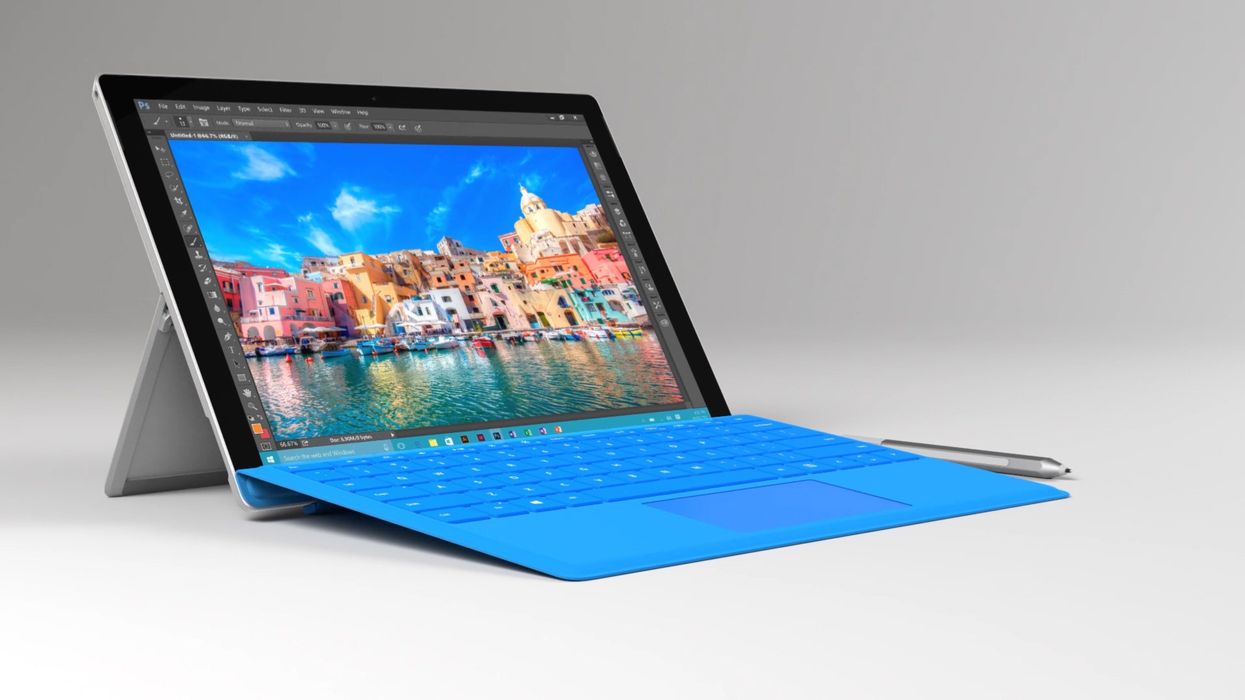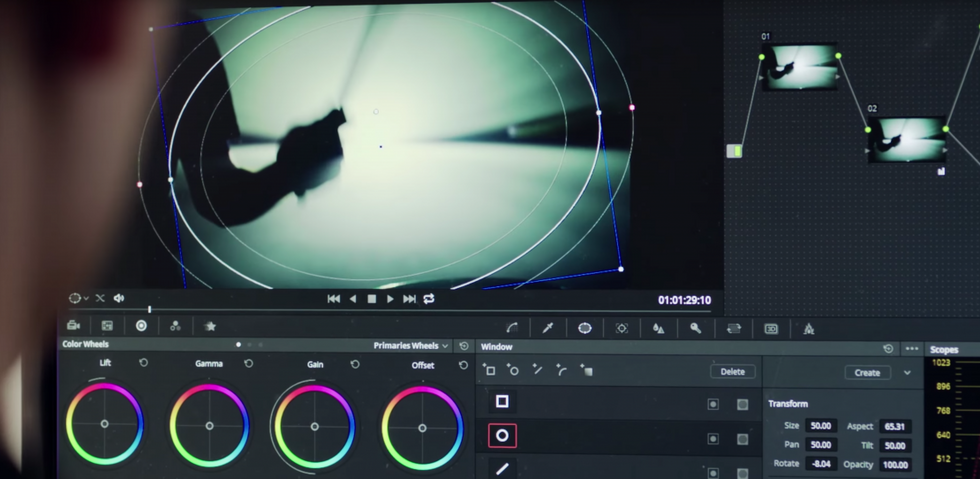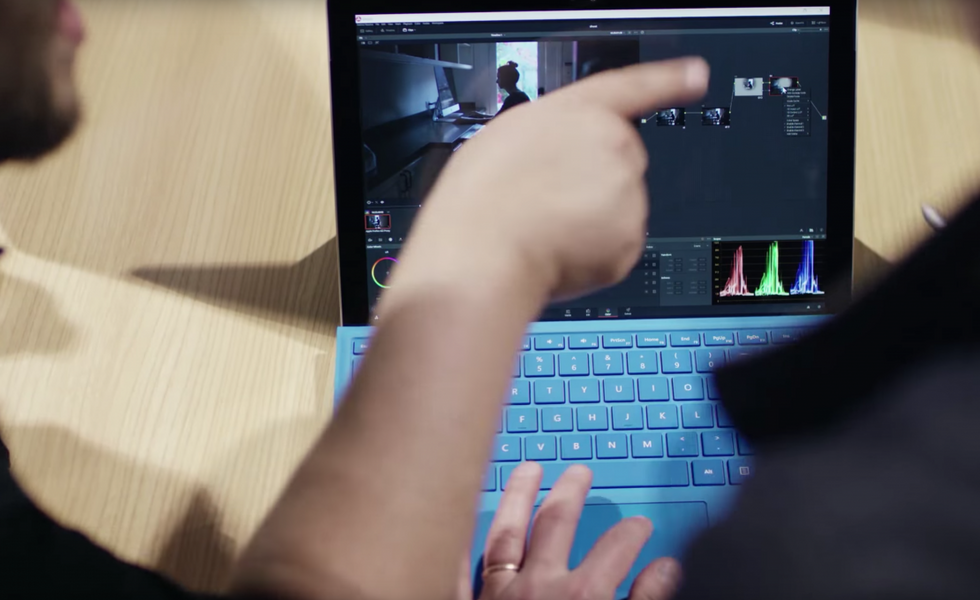Painting Footage: How Viable is Microsoft Surface for Color Grading?
We tested the Microsoft Surface for color grading. Here's how it holds up.

BlackMagic Design has been touting Intel support for Resolve since July of last year, setting the stage for Microsoft to take advantage of the partnership with its recent line of touch-screen Surface tablets.
Professional color grading will always demand high-end machines, control surfaces, calibrated monitors, and specific lighting conditions. But in the near future, not every colorist will be a professional. Resolve's nonexistent price tag ensures that even the most casual users will find a reason to color their home videos and Instagram posts with a bit more finesse. The question is whether the technology at the consumer tablet level is there yet.
We decided to find out.
In the professional space, the Surface is framed as a platform to scratch out initial grading ideas; it's not necessarily a device to take the job all the way.
Out of the box
The Microsoft Surface, which sports an Intel Core i7 2.20Ghz processor, 8GB RAM, and a 13-inch screen, is one possible candidate. The tablet is as light as you'd expect for a display of that size. It offers a comfortable ergonomic design with a kickstand-style back plate.
The screen is touch-sensitive—you can use tactile feedback to affect Resolve's color wheels. But if you can't bear to smear your screen over a long grading session, a Wacom-style pen is included to provide an alternative to the traditional trackpad. Unlike a Wacom, the pen doesn't feature additional buttons on its side, but it does have an eraser—which, when clicked, opens Microsoft's OneNote application.
The Microsoft Surface will never replace a powerful desktop system—or even a laptop—but it's not meant to.
In addition to a standard-issue headphone jack, a single USB port and one DisplayPort connector are provided for limited expandability.
Intended use
The Microsoft Surface will never replace a powerful desktop system—or even a laptop—but it's not meant to. For professionals, the tablet can be used for working in both close quarters and faraway locations or sketching a few quick looks while on set to excite the client. An on-set tablet can perform tests to determine if a product's hue can be shifted in a grading suite later, enabling smarter decisions to avoid agony and cost overages in post.
But the lack of several USB ports can't help but dissuade users from hooking a bunch of peripherals to the tablet. Mahesh Madhav, Architect for CPU and Media Technologies at Intel, said that "it all depends on the user experience you want. As peripherals are added, we start to make the system look more like a typical desktop PC, which misses the point."
While the added mobility of the Surface gets colorists out of the office, it would be nice to have a couple extra ports for a mouse, at least, since the Resolve USB dongle or an external hard drive housing the footage will be occupying the only USB connector. For professionals who wish to utilize Resolve's excellent noise reduction (a premium feature), the idea of copying footage locally before plugging the dongle back in is quite a pain and would warrant the purchase of a USB hub.
Using Resolve on personal video provides a gateway into the world of color correction.
For the layperson, using Resolve on personal video provides a gateway into the world of color correction; most will not feel undue stress from a system that will largely accommodate single primary corrections on low-resolution camera and phone footage before outputting. For these users, Resolve's home application will be similar to Photoshop: basic brightness, contrast, color balance, and vibrancy operation.
If you're wondering why anyone would want to grade on a tablet, the answer is that a tablet is more likely to be around when you need it. Maybe you're at home on the weekend and don't want to go back to the office, or you get client notes on a piece while on vacation. Sometimes, you just have to use the tool at hand. As to how to use Resolve on a tablet, limiting your node tree and accepting slow processing is the answer. Long render times are a small price to pay for being able to sweeten your weekend videos while lounging on your couch.

The screen
The irreconcilable tension between tablets is the inverse relation between their portability and screen size: as one increases, the other decreases. With a native resolution of a whopping 2736 x 1824 on a 13-inch screen, the pixels are densely packed. Unfortunately, this means Resolve's interface is absolutely microscopic, making it difficult to read the text and interact with the color wheels.
In these scenarios, right-clicking on the Desktop and selecting the Personalize option enables users to scale applications to a more legible level. This works for many native Windows apps; Microsoft asks third-party developers to code with a new display API that allows for this scaling, but at the time of this writing Resolve does not support this. (Blackmagic is aware of this issue.)
When you use the pen, it feels like you're painting the footage.
For now, this annoyance can be remedied by dropping the resolution to something like 1440 x 900, which at least prevents one from squinting at the screen to read timecodes, data values, and shot names. At this setting, I would recommend deselecting the Clips and Timeline on the Color page to give more screen real estate to the Viewer.
Regardless of the application, it's best to connect an external monitor through the DisplayPort to better see the results of a grade.
Coloring
Without a control panel, the sensitivity to the color wheels remains consistent whether using the trackpad or pen. For extreme grades, you'll find yourself pushing the wheels around quite a bit. For new users and those used to a control surface alike, it will take some time to get used to coloring in this manner, but at least the software's response to the dials is immediately visible in the footage.
When you use the pen, it feels like you're painting the footage. It's an experience surely different from coloring with a control panel, but no less fun or intuitive.
Playback
The Surface ingested a 5K RED clip as well as an HD ProRes 4444 Quicktime. Of course, on such a system, a RED clip needed debayering for smooth playback, and achieved real-time playback at 1/8th quality—which, for the purposes of applying a simple grade, is adequate in the field. The RED clip held up with near-real-time playback of 17-20fps with multiple primary nodes.
The ProRes 4444 fared less well, unable to sustain real-time playback with a single overall correction applied. But utilizing Smart mode of the Render Cache improved things considerably, similar to a more robust desktop suffering under the strain of heavy footage.
Garden-variety low bitrate H264-encoded media, characteristic of footage for many casual users, performed the best. All of the clips suffered more severe dropped frame issues when playing them in reverse, which is a normal function in a typical edit bay.

Render time
For professional users dealing with raw footage on set, stills will likely be the most common output for sharing with other members of the creative team, since footage will not yet have been finely selected. For casual home users, Resolve's preset Vimeo and YouTube outputs will be the most common.
In the professional space, the Surface is framed as a place to scratch out initial grading ideas; it's not necessarily a device to take the job all the way to its final output. Nevertheless, render times are indicative of how well the hardware performs overall.
Here are the render times for five seconds of video for each file format, each rendered to DNxHD 1080p 444. Use these benchmarks as an estimate for how much time it would take to render your project:
- 5K RED at full debayer: 44 seconds (1:8.8 footage time to render time ratio)
- Prores 4444: 16 seconds (1:3.2 footage time to render time ratio)
- H264: 9 seconds (1:1.8 footage time to render time ratio)
Conclusion
Color grading on a remote beach is a real possibility in the near future. Though the Surface won't replace desktops or robust laptops anytime soon, its mere responsiveness is welcome, particularly to those of us who tire of the darkened suites associated with our daily grind. Color grading systems used to cost millions of dollars, and the new tablet generation will make it easier— albeit slower, of course— to dial in and share looks.
While fill a niche need for professionals traveling with a heavy laptop, accessibility to the home user will no doubt be the successful arena here.
The Microsoft Surface is available now via Amazon or Microsoft's official store.
The video in this post was produced by Authors Projects.












